Stakeholders Mapping for Sustainable Biofuels: An Innovative Procedure Based on Computational Text Analysis and Social Network Analysis
Abstract
1. Introduction
1.1. Stakeholder Analysis
- (1)
- A computational text analysis technique for the identification of each stakeholder’s discursive topics, capable of detecting their interests in terms of such topics’ matching degree with the ABC-Salt project’s core contents. To operationalize the “Interest” dimension, keywords are extracted from the core ABC-Salt project’s publicly produced concepts and contents. Then, the core contents of the ABC-Salt project are extracted from both Factiva and ProQuest, two well-known digital databases of business contents frequently used as data source for management studies [11,12,13]. Finally, a Structural Topic Model (STM) is applied to highlight topics relevant for the ABC-Salt project’s related contents. The “Interest” dimension of the ABC-Salt stakeholders is then calculated through the adherence between such ABC-Salt-related topics and the stakeholders’ publicly produced contents: specifically, it is operationalized as the Evidence Lower Bound [14,15,16], i.e., ELBO, an index of fit between a stakeholder’s textual content and the ABC-Salt topic model. In sustainability acceptance terms, it is important to know to what extent the contents characterizing each stakeholder overlap with the contents of the actor proposing the new sustainable technology.
- (2)
- A quantitative SNA approach for the construction of the stakeholder network. To operationalize the dimension of “Influence”, instead, a preliminary search of the ABC-Salt project’s potential stakeholders is made from the online database ETIP (European Technology and Innovation Platform, in particular the ETIP Bioenergy: http://biofuelstp.eu/); then, through Twitter API’s (Application Programming Interface, a set of functions and procedures allowing the creation of applications that access Twitter features or data), information is extracted from the specific stakeholders identified (see Section 2.2). This allows us to build a network based on mutual relations to enable the computation of “Influence” through the In-degree Centrality index. In sustainability acceptance terms, it is important to know to what extent each stakeholder is central, i.e., influent, within the social network of stakeholders which are relevant for the proposed new sustainable technology.
1.1.1. Structural Topic Model
1.1.2. Social Network Analysis
1.2. Aims
- To identify a limited amount of topics capable to describe the ABC-Salt project’s main sustainability contents and then to measure, within a given stakeholders network, the degree by which each stakeholder’s produced textual data overlap with such project’s topic contents (by means of the Evidence Lower Bound index);
- To identify, within a given stakeholders network on that sustainability issue, each stakeholder’s centrality (by means of the In-degree index);
- To populate an Interest by Influence Mendelow’s matrix by means of all sampled stakeholders, within the considered set, by crossing the two aforementioned metrics. Moreover, in order to provide a more detailed stakeholders profiling: to describe the matrix quadrants via the contents of interest (topics) characterizing the stakeholders within each specific quadrant.
2. Materials and Methods
2.1. Keywords and Topic Extraction (STM Procedure)
2.1.1. ABC-Salt Contents Definition
- First Level Keywords are the two biggest nodes, circa 95th percentile in Weighted Degree Distribution (WD > 72.9): “Biofuel” and “Biomass”;
- Second Level Keywords are the subsequent six nodes, 75th percentile (WD > 30): “Research”, “Molten salts”, “Energy”, “Sustainable”, “Fuel”, “Middle Distillates”.
2.1.2. Validation via a Concurrent Strategy for ABC-Salt-Related Content Extraction
- First Level Keywords are the three bigger red nodes: “Biofuel”, “Biomass” and “Molten Salt”;
- Second Level Keywords are the subsequent seven smaller blue nodes: “Research”, “Energy”, “Sustainable”, “Fuel”, “Middle Distillates”, “Liquid” and “Hydro-Pyrolysis”.
2.1.3. ABC-Salt-Related Contents from Global News Databases
2.1.4. ABC-Salt-Related Topics
- Semantic Coherence [30] is part of the broader concept of mutual information and is based on the probability of the terms of a topic to co-occur in documents;
- Exclusivity, based on the FREX index, refers to the specificity of words ascribed to a topic.
2.2. Stakeholder Identification (SNA Procedure)
- Existence of an official English language website (subsequently used to extract text content);
- Existence of a Twitter account (later used to investigate influence in the digital environment);
2.2.1. Stakeholders’ Data Gathering
2.2.2. Stakeholders’ Network Drawing
- Following (Stakeholder A follows status and content updates of a stakeholder B);
- Retweeting (Stakeholder A spread a communication content produced by stakeholder B);
- Mentioning (Stakeholder A cites stakeholder B in its own communication).
3. Results
3.1. Interest Computation (STM Procedure)
3.2. Influence Computation (SNA Procedure)
3.3. Matrix Population
4. Discussion
5. Conclusions
Author Contributions
Funding
Acknowledgments
Conflicts of Interest
Appendix A
| ORG NAME | COUNTRY | ELBO_STD | INDEG_STD |
|---|---|---|---|
| ACEA | Belgium | −0.103 | 0.450 |
| AEBIOM | Belgium | −0.935 | 3.561 |
| Bellona Organisation | Belgium | −1.885 | −0.217 |
| Cargill | Belgium | −1.916 | 0.783 |
| Confederation of European Forest Owners | Belgium | −2.973 | 0.228 |
| Copa—Cogeca | Belgium | −8.905 | 1.117 |
| EPSO | Belgium | 0.261 | −0.106 |
| ePure | Belgium | 0.474 | 2.450 |
| EREC | Belgium | 0.434 | −0.994 |
| ESA—European Seed Association | Belgium | 0.380 | 0.228 |
| essenscia | Belgium | 0.329 | −0.772 |
| EUBIA | Belgium | 0.379 | 1.895 |
| EUFORES | Belgium | 0.484 | 0.117 |
| EUREC Agency | Belgium | 0.406 | 0.228 |
| EuropaBio/SusChem | Belgium | −0.045 | 2.339 |
| European Biodiesel Board (EBB) | Belgium | 0.546 | 0.672 |
| EWABA | Belgium | 0.089 | 0.006 |
| FEDARENE | Belgium | −0.309 | 0.228 |
| FEDIOL | Belgium | 0.117 | −0.994 |
| Praxair | Belgium | 0.497 | −0.772 |
| Prince of Wales’s EU Corporate Leaders Group on Climate Change (CLG) | Belgium | 0.563 | −0.328 |
| Schuttelaar & Partners | Belgium | 0.436 | −0.883 |
| SGS | Belgium | 0.366 | −0.439 |
| UNICA—EU Office | Belgium | 0.415 | −0.550 |
| University of Ghent—Ghent Bio-economy | Belgium | 0.530 | 0.228 |
| ValBiom | Belgium | 0.573 | 0.117 |
| VITO Crossroads of Technology | Belgium | 0.567 | 0.672 |
| Vrije Universiteit Brussel (VUB) | Belgium | 0.536 | −0.994 |
| ADEME | France | −0.966 | 1.561 |
| Agence nationale de la recherche | France | −0.422 | −0.217 |
| Air Liquide | France | −0.685 | 1.117 |
| BUNGE | France | −3.153 | −0.883 |
| Bureau Veritas | France | −3.278 | −0.661 |
| CIRAD | France | −0.208 | 0.339 |
| Deinove | France | −0.407 | −0.439 |
| GDF SUEZ | France | 0.283 | 1.895 |
| IFP Energies Nouvelles | France | 0.063 | 0.228 |
| INERIS | France | 0.534 | −0.550 |
| Investissements d’avenir (CGI) | France | 0.024 | 0.339 |
| ONERA | France | 0.610 | −0.550 |
| PROLEA | France | 0.666 | −0.772 |
| PSA Peugeot Citroen | France | 0.508 | 0.117 |
| Safran Group | France | 0.564 | −0.439 |
| SNPAA | France | 0.450 | −0.439 |
| Sofinnova Partners | France | 0.096 | −0.550 |
| Syndicat des énergies renouvelable | France | 0.418 | 0.117 |
| Technip | France | 0.467 | 0.006 |
| TOTAL | France | 0.468 | 4.117 |
| ADM European Management Holding GmbH | Germany | 0.176 | −0.328 |
| Agentur für Erneuerbare Energien e.V. | Germany | −0.150 | −0.106 |
| AGQM Arbeitsgemeinschaft Qualitätsmanagement Biodiesel e.V. | Germany | 0.078 | −0.439 |
| BASF Aktiengesellschaft | Germany | −0.604 | 3.450 |
| Bundesverband Erneuerbare Energie (BEE) | Germany | −0.833 | 0.117 |
| Caterpillar Motoren GmbH & Co. KG | Germany | −1.621 | −0.328 |
| Clariant | Germany | 0.528 | 1.228 |
| DBFZ | Germany | −0.836 | 0.228 |
| DECHEMA e.V. | Germany | −0.481 | −0.106 |
| FEV Motorentechnik GmbH | Germany | −0.263 | −0.883 |
| Ford Forschungszentrum Aachen GmbH | Germany | 0.597 | 0.117 |
| Fraunhofer ISI | Germany | −0.209 | −0.217 |
| General Motors Europe | Germany | 0.368 | −0.439 |
| ISCC System GmbH | Germany | 0.378 | 0.006 |
| KIC InnoEnergy Germany | Germany | 0.010 | 0.783 |
| KWS Saat AG | Germany | 0.263 | −0.328 |
| Lanxess Deutschland GmbH | Germany | 0.355 | −0.106 |
| Petrotec AG | Germany | 0.501 | 0.117 |
| TUM—TU München | Germany | 0.299 | 0.006 |
| Union for the Promotion of Oil and Protein Plants (UFOP) | Germany | 0.354 | 0.561 |
| Verband der Deutschen Biokraftstoffindustrie e.V. (VDB) | Germany | 0.395 | 1.339 |
| WIP Renewable Energy | Germany | 0.258 | −0.106 |
| ARGO S.r.l. | Italy | −1.889 | −0.994 |
| Bologna University | Italy | 0.111 | −0.439 |
| Central European Initiative (CEI) | Italy | −1.247 | −0.772 |
| Centro Ricerche Fiat (Fiat Powertrain Technologies) | Italy | −0.613 | −0.439 |
| ENI—Ente Nazionale Idrocarburi | Italy | 0.455 | 1.117 |
| ETA Renewable Energies | Italy | 0.541 | 0.228 |
| International Flame Research Foundation (IFRF) | Italy | 0.490 | −0.883 |
| Technip Italy s.p.a | Italy | 0.467 | 0.006 |
| Università degli Studi di Firenze | Italy | 0.667 | −0.661 |
| Università degli Studi di Udine | Italy | 0.667 | −0.772 |
| Avantium Technologies BV | The Netherlands | −2.064 | 0.006 |
| BTG Bioliquids BV | The Netherlands | −1.018 | 0.117 |
| BTG Biomass Technology Group | The Netherlands | −1.136 | −0.439 |
| Centre for Surface Chemistry and Catalysis. KU Leuven | The Netherlands | −0.528 | −0.217 |
| Energy Research Centre of The Netherlands (ECN) | The Netherlands | 0.449 | 0.450 |
| European Environmental Bureau | The Netherlands | −0.361 | −0.217 |
| FeyeCon D&I BV | The Netherlands | 0.033 | −0.994 |
| GoodFuels | The Netherlands | 0.259 | 0.006 |
| LyondellBasell Industries | The Netherlands | 0.413 | −0.328 |
| NEN The Netherlands Standardization Institute | The Netherlands | 0.189 | −0.883 |
| NL Agency | The Netherlands | 0.547 | −0.883 |
| PBL The Netherlands Environmental Assessment Agency | The Netherlands | 0.562 | −0.661 |
| Shell Global Solutions International BV | The Netherlands | 0.516 | 4.450 |
| SkyNRG | The Netherlands | 0.247 | 0.561 |
| Technip Benelux B.V. | The Netherlands | 0.467 | 0.006 |
| TNO | The Netherlands | 0.396 | −0.328 |
| CenBio | Norway | −3.440 | −0.661 |
| NIFU Nordic Institute for Studies in Innovation. Research and Education | Norway | 0.540 | −0.772 |
| Nordic Energy Research | Norway | 0.579 | −0.550 |
| Norsk Hydro ASA | Norway | 0.525 | −0.994 |
| Norwegian University of Science and Technology NTNU | Norway | 0.653 | 1.006 |
| Research Council of Norway—ENERGIX | Norway | 0.284 | 0.117 |
| SINTEF | Norway | 0.356 | 1.006 |
| Bioenergy International | Sweden | −0.965 | 4.673 |
| f3 The Swedish Knowledge Centre for Renewable Transportation Fuels | Sweden | 0.145 | −0.328 |
| Formas | Sweden | 0.583 | −0.217 |
| Fysisk resursteori CTH/GU | Sweden | 0.370 | 0.006 |
| Göteborg Energi AB | Sweden | 0.323 | −0.883 |
| Lund University Biofuels | Sweden | 0.307 | 0.450 |
| Lunds Tekniska Högskola | Sweden | 0.474 | 0.450 |
| Perstorp | Sweden | 0.620 | −0.328 |
| PREEM | Sweden | 0.526 | 0.228 |
| Scania | Sweden | 0.540 | 0.783 |
| SEKAB BioFuel Industries | Sweden | 0.467 | 0.006 |
| SLU—Unit for Field-Based Forest Research | Sweden | 0.645 | 1.006 |
| STEM—Swedish Energy Agency | Sweden | 0.516 | 1.117 |
| Sveaskog | Sweden | 0.442 | 0.228 |
| Swedish District Heating Association | Sweden | 0.375 | 0.450 |
| SÖDRA | Sweden | 0.581 | 0.117 |
| Vattenfall—CCS R&D | Sweden | 0.545 | 1.228 |
| Vinnova | Sweden | 0.569 | 0.672 |
| Accenture | UK | 0.142 | 0.228 |
| Argus Media | UK | −0.533 | 0.672 |
| BBSRC—Biotechnology and Biological Sciences Research Council | UK | −0.178 | 0.672 |
| Booz Allen Hamilton | UK | −0.738 | −0.994 |
| BP | UK | −2.585 | 1.672 |
| British Agriculture Bureau | UK | −0.856 | 0.450 |
| Cardiff University—Institute of Energy | UK | −0.936 | −0.328 |
| Centre for Process Innovation | UK | −2.350 | −0.550 |
| Energy Technologies Institute | UK | 0.618 | −0.106 |
| European Energy Innovation—Prologue Media | UK | 0.539 | 0.228 |
| European Energy Investments Limited | UK | 0.265 | −0.994 |
| Heriot-Watt University | UK | 0.560 | −0.550 |
| Imperial College London—ICEPT | UK | 0.002 | 1.339 |
| INEOS Bio Limited | UK | −0.067 | 0.450 |
| Invensys (Shneider Electric) | UK | 0.268 | 0.672 |
| Low Carbon Vehicle Partnership | UK | 0.515 | −0.439 |
| Lubrizol Ltd. | UK | 0.435 | −0.661 |
| National Non-Food Crops Centre | UK | 0.418 | 1.672 |
| NEPIC | UK | 0.202 | −0.328 |
| New Energy Farms | UK | 0.543 | −0.439 |
| Newcastle University | UK | 0.591 | −0.328 |
| Norton Rose LLP | UK | 0.560 | −0.994 |
| Scottish Association for Marine Science | UK | 0.546 | −0.439 |
| StrategicFit | UK | 0.547 | −0.994 |
| Syngenta Seeds Ltd. | UK | 0.419 | 0.672 |
| Technology Strategy Board | UK | 0.606 | 1.561 |
| University of Leeds | UK | 0.581 | −0.994 |
| Velocys | UK | 0.508 | −0.772 |
References
- Grimble, R.; Wellard, K. Stakeholder Methodologies in Natural Resource Management: A Review of Principles, Contexts, Experiences and Opportunities. Agric. Syst. 1997, 55, 173–193. [Google Scholar] [CrossRef]
- Reed, M.S.; Graves, A.; Dandy, N.; Posthumus, H.; Hubacek, K.; Morris, J.; Prell, C.; Quinn, C.H.; Stringer, L.C. Who’s in and Why? A Typology of Stakeholder Analysis Methods for Natural Resource Management. J. Environ. Manag. 2009, 90, 1933–1949. [Google Scholar] [CrossRef] [PubMed]
- Brugha, R.; Varvasovszky, Z. Stakeholder Analysis: A Review. Health Policy Plan. 2000, 15, 239–246. [Google Scholar] [CrossRef] [PubMed]
- Savage, G.T.; Nix, T.W.; Whitehead, C.J.; Blair, J.D. Strategies for Assessing and Managing Organizational Stakeholders. Acad. Manag. Perspect. 1991, 5, 61–75. [Google Scholar] [CrossRef]
- Bourne, L.; Weaver, P. Mapping Stakeholders. Constr. Stakehold. Manag. 2010, 99–120. [Google Scholar] [CrossRef]
- Bonaiuto, M.; Ludovico, N.; Dessi, F.; La Bella, A. Deliverable 2.4. Stakeholders Map for Socio-Economic Evaluation. In EC H2020 ABC-Salt WP2—Techno-Economic Evaluation—Socio-Economic—Environmental Aspects; Grant Agreement N° 764089; European Community: Maastricht, The Netherlands, 2019. [Google Scholar]
- Markwick, M.C. Golf Tourism Development, Stakeholders, Differing Discourses and Alternative Agendas: The Case of Malta. Tour. Manag. 2000, 21, 515–524. [Google Scholar] [CrossRef]
- Kuzmin, O.; Khilukha, O. Regulation of Stakeholders’ Interests in Corporate Governance through Negotiations. Економічний часопис-ХХІ 2016, 161, 56–60. [Google Scholar] [CrossRef]
- Walker, D.H.; Bourne, L.M.; Shelley, A. Influence, Stakeholder Mapping and Visualization. Constr. Manag. Econ. 2008, 26, 645–658. [Google Scholar] [CrossRef]
- Reed, M.S.; Curzon, R. Stakeholder Mapping for the Governance of Biosecurity: A Literature Review. J. Integr. Environ. Sci. 2015, 12, 15–38. [Google Scholar] [CrossRef]
- Sullivan, K.; Thomas, S.; Rosano, M. Using Industrial Ecology and Strategic Management Concepts to Pursue the Sustainable Development Goals. J. Clean. Prod. 2018, 174, 237–246. [Google Scholar] [CrossRef]
- Johal, R. Factiva: Gateway to Business Information. J. Bus. Financ. Librariansh. 2009, 15, 60–64. [Google Scholar] [CrossRef]
- Scales, B.J.; Gilles, M.M. Lexis-Nexis in an Academic Reference Environment: User Policies and Instruction Methods. Ref. Serv. Rev. 1995, 23, 85–96. [Google Scholar] [CrossRef]
- Roberts, M.E.; Stewart, B.M.; Airoldi, E.M. A Model of Text for Experimentation in the Social Sciences. J. Am. Stat. Assoc. 2016, 111, 988–1003. [Google Scholar] [CrossRef]
- Bi, Y.; Bhatia, R.; Kapoor, S. Intelligent Systems and Applications: Proceedings of the 2019 Intelligent Systems Conference (IntelliSys); Springer Nature: Cham, Switzerland, 2019; Volume 1. [Google Scholar]
- Xu, W.; Tan, Y. Semisupervised Text Classification by Variational Autoencoder. IEEE Trans. Neural Networks Learn. Syst. 2019, 31, 295–308. [Google Scholar] [CrossRef] [PubMed]
- Mohr, J.W.; Bogdanov, P. Introduction—Topic Models: What They Are and Why They Matter; Elsevier: New York, NY, USA, 2013. [Google Scholar]
- Bholat, D.; Hansen, S.; Santos, P.; Schonhardt-Bailey, C. Text Mining for Central Banks. 2015. Available online: https://papers.ssrn.com/sol3/papers.cfm?abstract_id=2624811 (accessed on 1 October 2020). [CrossRef]
- Roberts, M.E.; Stewart, B.M.; Tingley, D.; Airoldi, E.M. The Structural Topic Model and Applied Social Science. In Advances in Neural Information Processing Systems Workshop on Topic Models: Computation, Application and Evaluation; Harrahs and Harveys: Lake Tahoe, NV, USA, 2013; Volume 4. [Google Scholar]
- Roberts, M.E.; Stewart, B.M.; Tingley, D.; Lucas, C.; Leder-Luis, J.; Gadarian, S.K.; Albertson, B.; Rand, D.G. Structural Topic Models for Open-Ended Survey Responses. Am. J. Polit. Sci. 2014, 58, 1064–1082. [Google Scholar] [CrossRef]
- Roberts, M.E.; Stewart, B.M.; Tingley, D. Stm: R Package for Structural Topic Models. J. Stat. Softw. 2014, 10, 1–40. [Google Scholar] [CrossRef]
- Berge, C. La Theorie Des Graphes. In Development of Mathematics; Birkhauser: Basel, Switzerland, 2001; Volume 1. [Google Scholar]
- Wasserman, S.; Faust, K. Social Network Analysis: Methods and Applications; Cambridge University Press: Cambridge, UK, 1994; Volume 8. [Google Scholar]
- Freeman, L.C.; Roeder, D.; Mulholland, R.R. Centrality in Social Networks: II. Experimental Results. Soc. Networks 1979, 2, 119–141. [Google Scholar] [CrossRef]
- Prell, C.; Hubacek, K.; Reed, M. Stakeholder Analysis and Social Network Analysis in Natural Resource Management. Soc. Nat. Resour. 2009, 22, 501–518. [Google Scholar] [CrossRef]
- Bodin, Ö.; Crona, B.; Ernstson, H. Social Networks in Natural Resource Management: What Is There to Learn from a Structural Perspective? Ecol. Soc. 2006, 11, r2. [Google Scholar] [CrossRef]
- Marsden, P.V.; Friedkin, N.E. Network Studies of Social Influence. In Advances in Social Network Analysis: Research in the Social and Behavioral Sciences; Sage Focus Editions: Thousand Oaks, CA, USA, 1994; Volume 171, pp. 3–25. [Google Scholar]
- ABC Salt. Available online: https://www.abc-salt.eu/ (accessed on 14 July 2020).
- Mimno, D.; Lee, M. Low-Dimensional Embeddings for Interpretable Anchor-Based Topic Inference. In Proceedings of the 2014 Conference on Empirical Methods in Natural Language Processing (EMNLP), Doha, Qatar, 25–29 October 2014; Association for Computational Linguistics: Doha, Qatar, 2014; pp. 1319–1328. [Google Scholar] [CrossRef]
- Mimno, D.; Wallach, H.; Talley, E.; Leenders, M.; McCallum, A. Optimizing Semantic Coherence in Topic Models. In Proceedings of the 2011 Conference on Empirical Methods in Natural Language Processing, Edinburgh, Scotland, 27–31 July 2011; Association for Computational Linguistics: Edinburgh, UK, 2011; pp. 262–272. [Google Scholar]
- Stakeholders—ETIP-B-SABS 2. Available online: https://www.etipbioenergy.eu/databases/stakeholders-db (accessed on 21 July 2020).
- Bastian, M.; Heymann, S.; Jacomy, M. Gephi: An Open Source Software for Exploring and Manipulating Networks. In Third International AAAI Conference on Weblogs and Social Media; ICWSM 2009: San Jose, CA, USA, 2009; pp. 361–362. [Google Scholar]
- Huberman, B.A.; Adamic, L.A. Growth Dynamics of the World-Wide Web. Nature 1999, 401, 131. [Google Scholar] [CrossRef]
- Adamic, L.A.; Huberman, B.A.; Barabási, A.L.; Albert, R.; Jeong, H.; Bianconi, G. Power-Law Distribution of the World Wide Web. Science 2000, 287, 2115. [Google Scholar] [CrossRef]
- Baltar, F.; Brunet, I. Social Research 2.0: Virtual Snowball Sampling Method Using Facebook. Internet Res. 2012. [Google Scholar] [CrossRef]
- Zamal, F.A.; Liu, W.; Ruths, D. Homophily and Latent Attribute Inference: Inferring Latent Attributes of Twitter Users from Neighbors. ICWSM 2012, 270, 387–390. [Google Scholar]
- McPherson, M.; Smith-Lovin, L.; Cook, J.M. Birds of a Feather: Homophily in Social Networks. Ann. Rev. Soc. 2001, 27, 415–444. [Google Scholar] [CrossRef]
- Morone, P.; Imbert, E. Food Waste and Social Acceptance of a Circular Bioeconomy: The Role of Stakeholders. Curr. Opin. Green Sustain. Chem. 2020. [Google Scholar] [CrossRef]
- Upham, P.; Oltra, C.; Boso, À. Towards a Cross-Paradigmatic Framework of the Social Acceptance of Energy Systems. Energy Res. Soc. Sci. 2015, 8, 100–112. [Google Scholar] [CrossRef]
- Wüstenhagen, R.; Wolsink, M.; Bürer, M.J. Social Acceptance of Renewable Energy Innovation: An Introduction to the Concept. Energy Policy 2007, 35, 2683–2691. [Google Scholar] [CrossRef]
- Enevoldsen, P.; Sovacool, B.K. Examining the Social Acceptance of Wind Energy: Practical Guidelines for Onshore Wind Project Development in France. Renew. Sustain. Energy Rev. 2016, 53, 178–184. [Google Scholar] [CrossRef]
- Balzarova, M.A.; Castka, P. Stakeholders’ Influence and Contribution to Social Standards Development: The Case of Multiple Stakeholder Approach to ISO 26000 Development. J. Bus. Ethics 2012, 111, 265–279. [Google Scholar] [CrossRef]
- Terwel, B.W.; Harinck, F.; Ellemers, N.; Daamen, D.D. Going beyond the Properties of CO2 Capture and Storage (CCS) Technology: How Trust in Stakeholders Affects Public Acceptance of CCS. Int. J. Greenh Gas. Control. 2011, 5, 181–188. [Google Scholar] [CrossRef]
- Terwel, B.W.; Harinck, F.; Ellemers, N.; Daamen, D.D. Competence-Based and Integrity-Based Trust as Predictors of Acceptance of Carbon Dioxide Capture and Storage (CCS). Risk Anal. Int. J. 2009, 29, 1129–1140. [Google Scholar] [CrossRef] [PubMed]
- Huijts, N.M.; Midden, C.J.; Meijnders, A.L. Social Acceptance of Carbon Dioxide Storage. Energy Policy 2007, 35, 2780–2789. [Google Scholar] [CrossRef]
- Wang, S.; Wang, J.; Lin, S.; Li, J. Public Perceptions and Acceptance of Nuclear Energy in China: The Role of Public Knowledge, Perceived Benefit, Perceived Risk and Public Engagement. Energy Policy 2019, 126, 352–360. [Google Scholar] [CrossRef]
- Assefa, G.; Frostell, B. Social Sustainability and Social Acceptance in Technology Assessment: A Case Study of Energy Technologies. Technol. Soc. 2007, 29, 63–78. [Google Scholar] [CrossRef]
- Barr, S. Strategies for Sustainability: Citizens and Responsible Environmental Behaviour. Area 2003, 35, 227–240. [Google Scholar] [CrossRef]
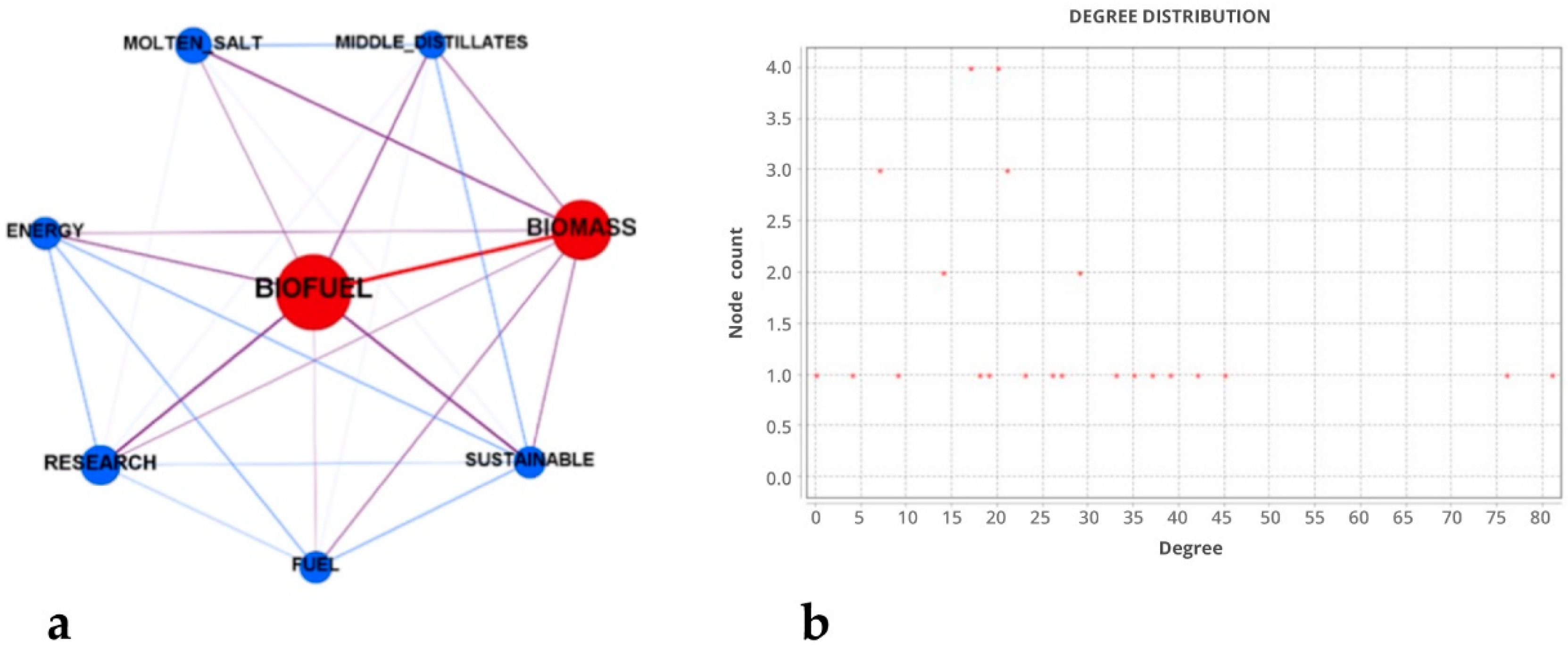
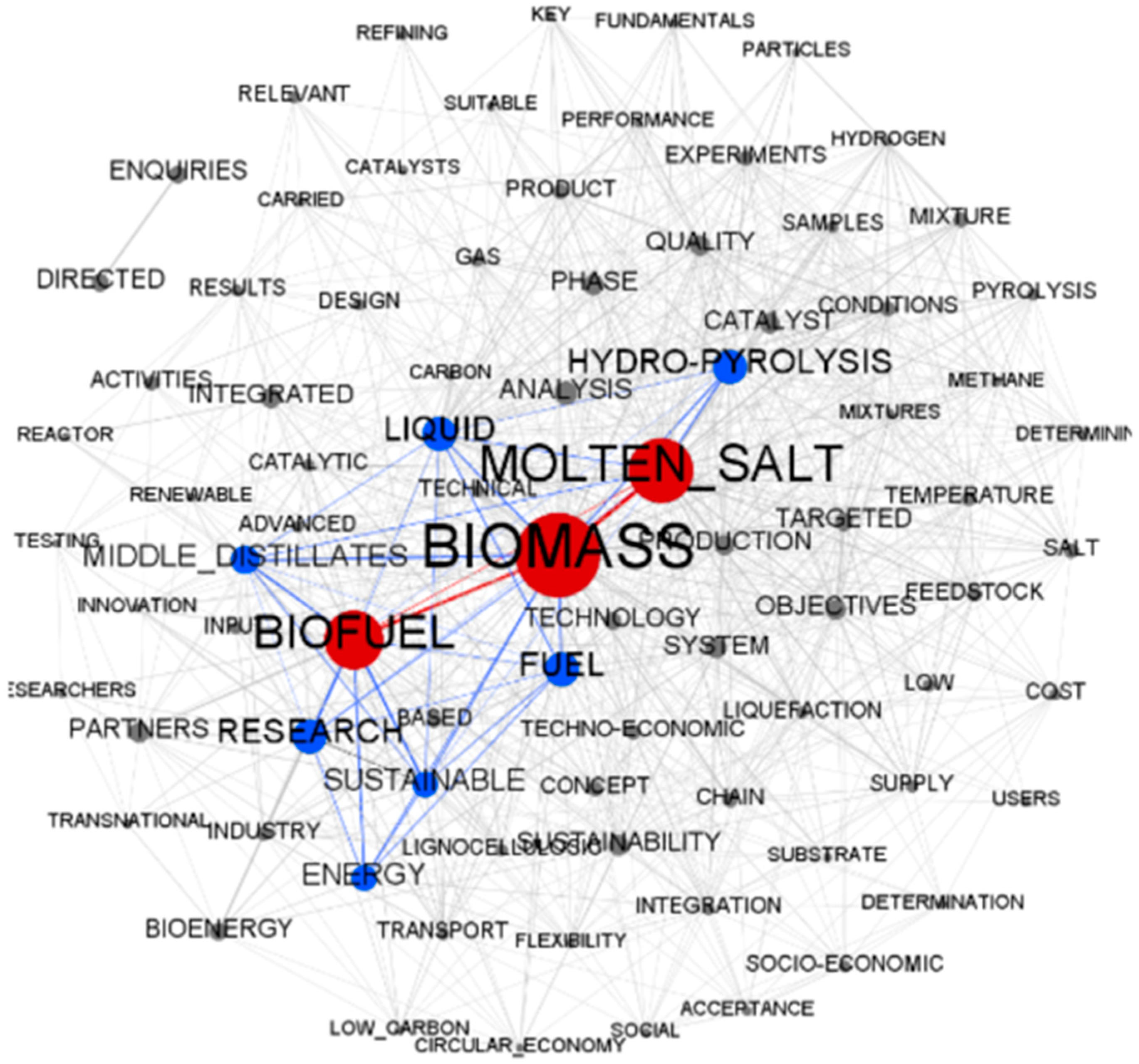
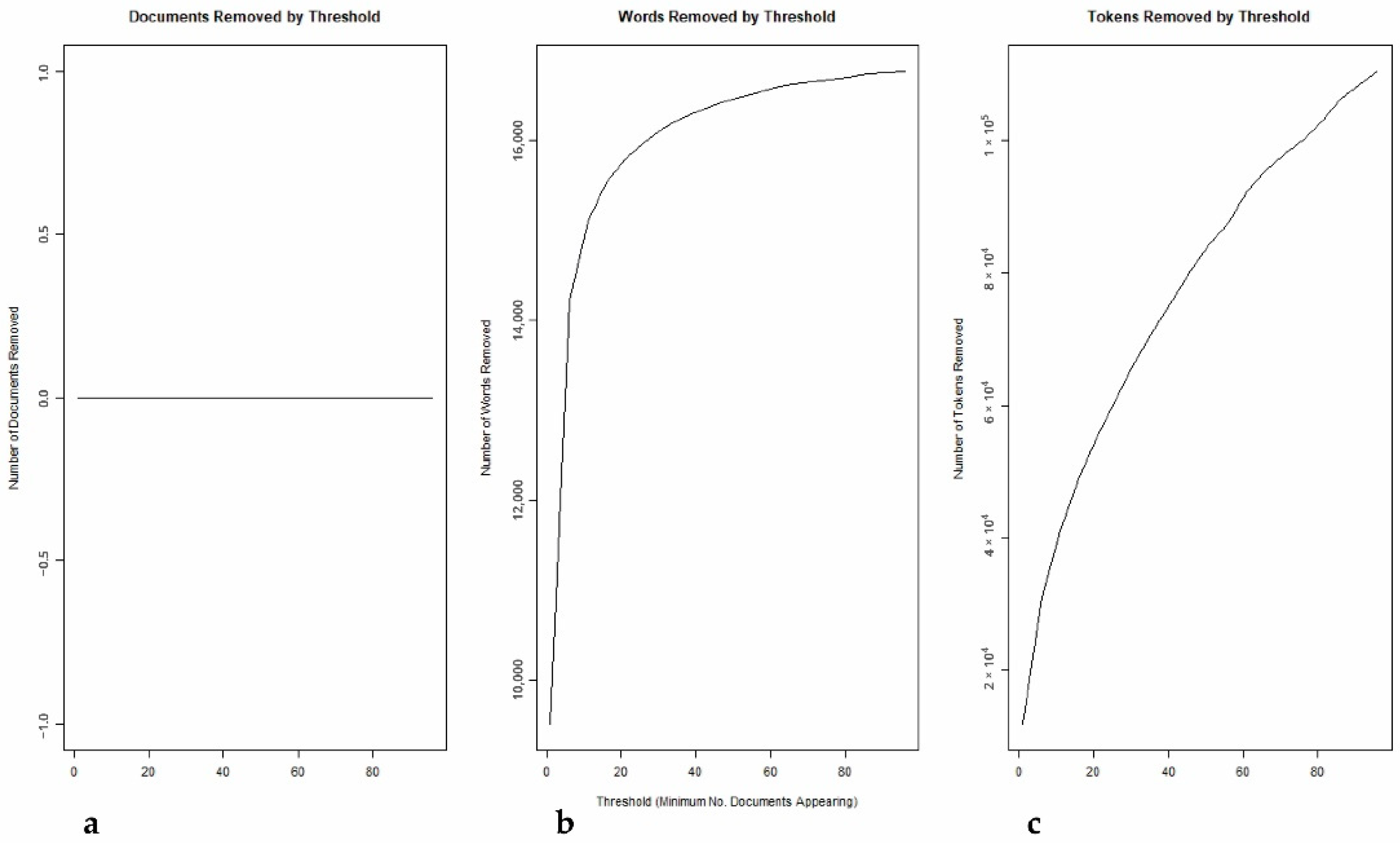
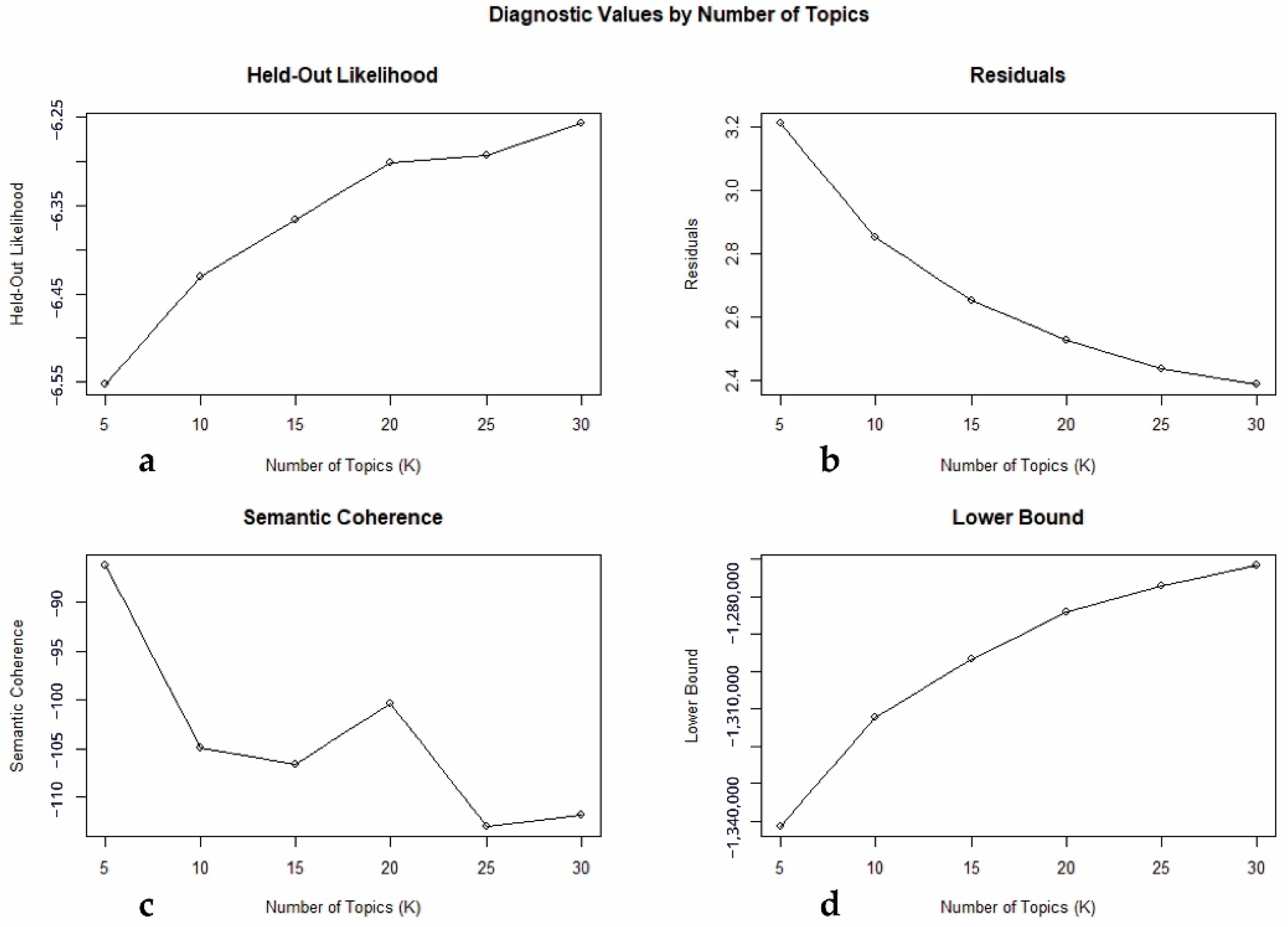
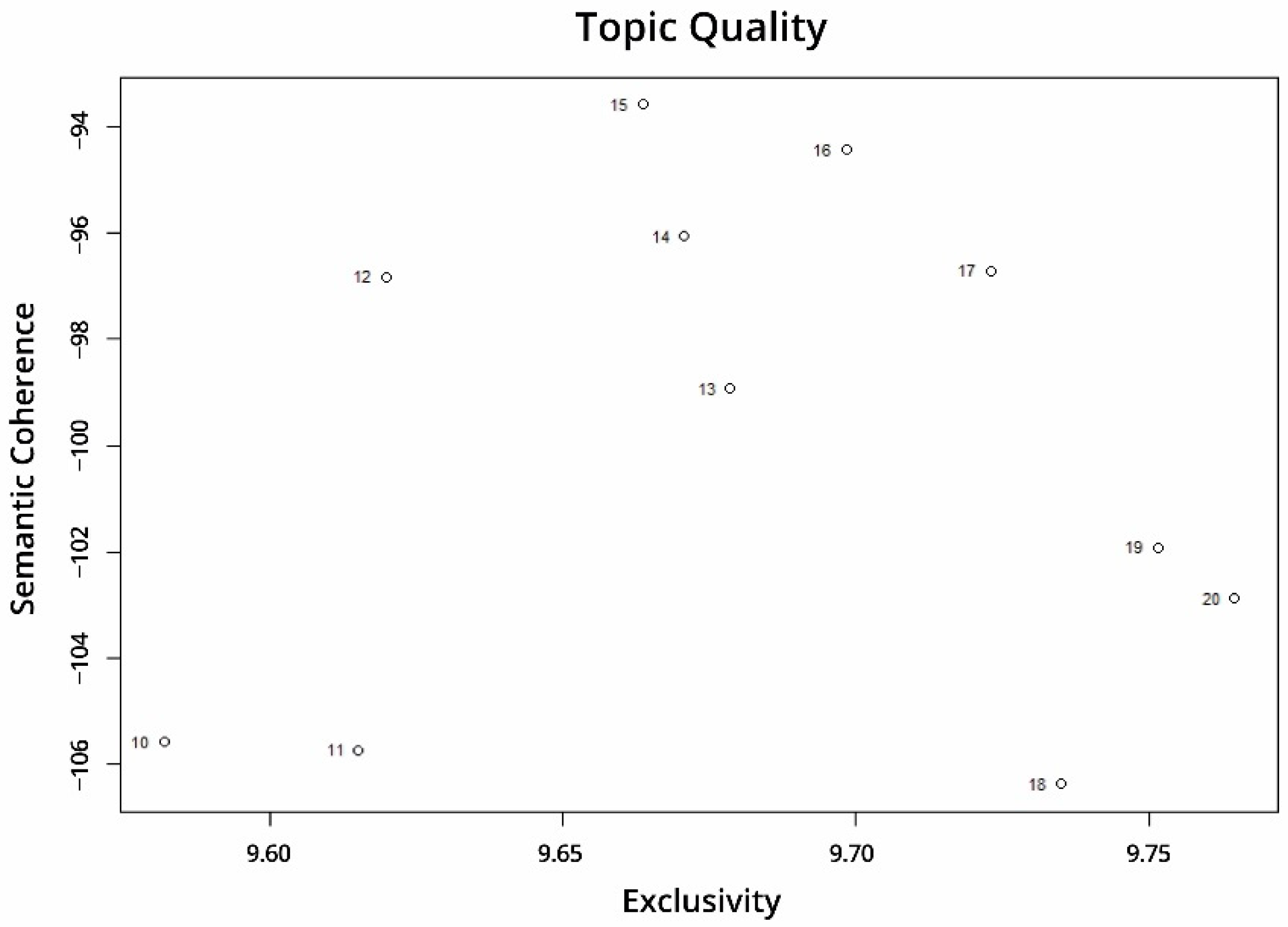

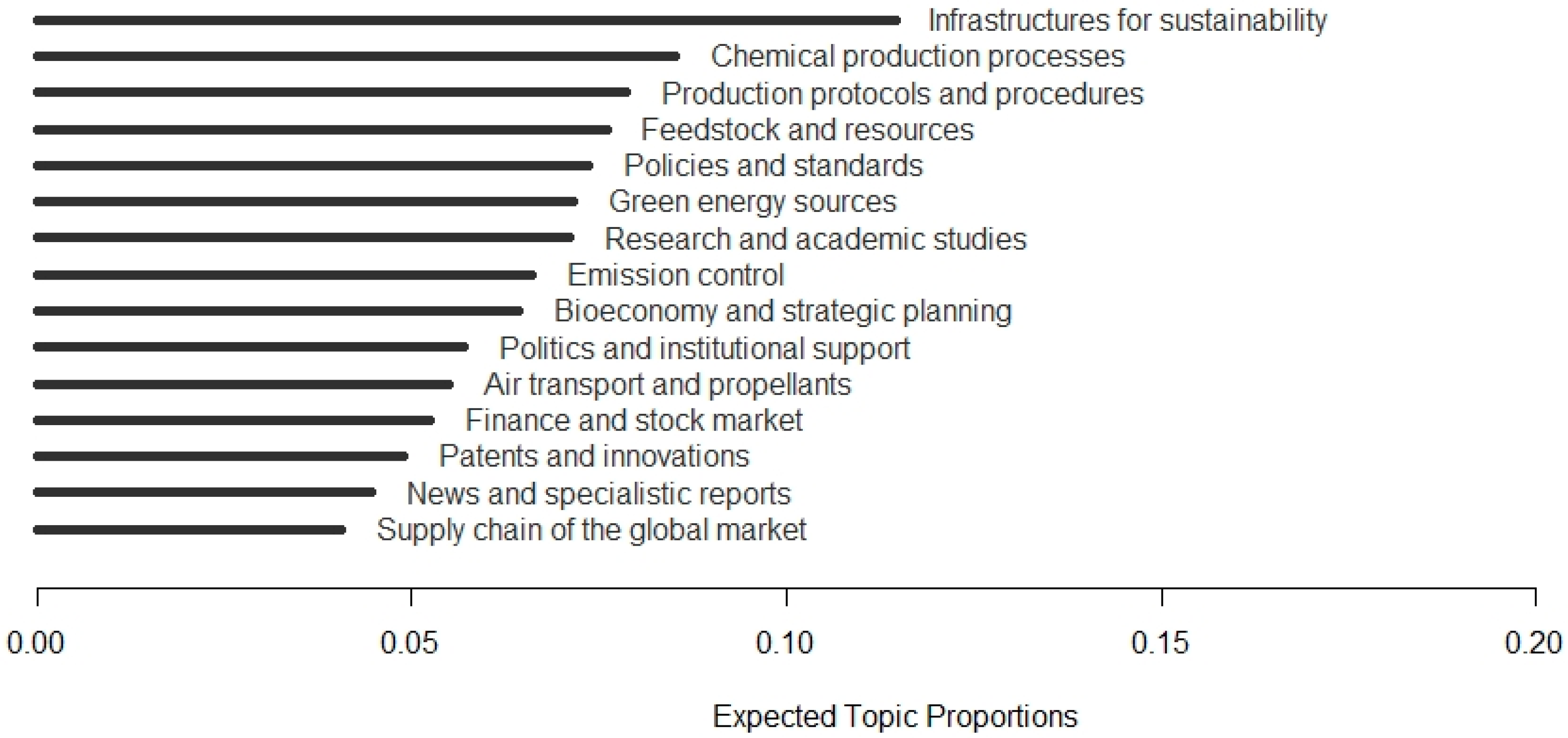



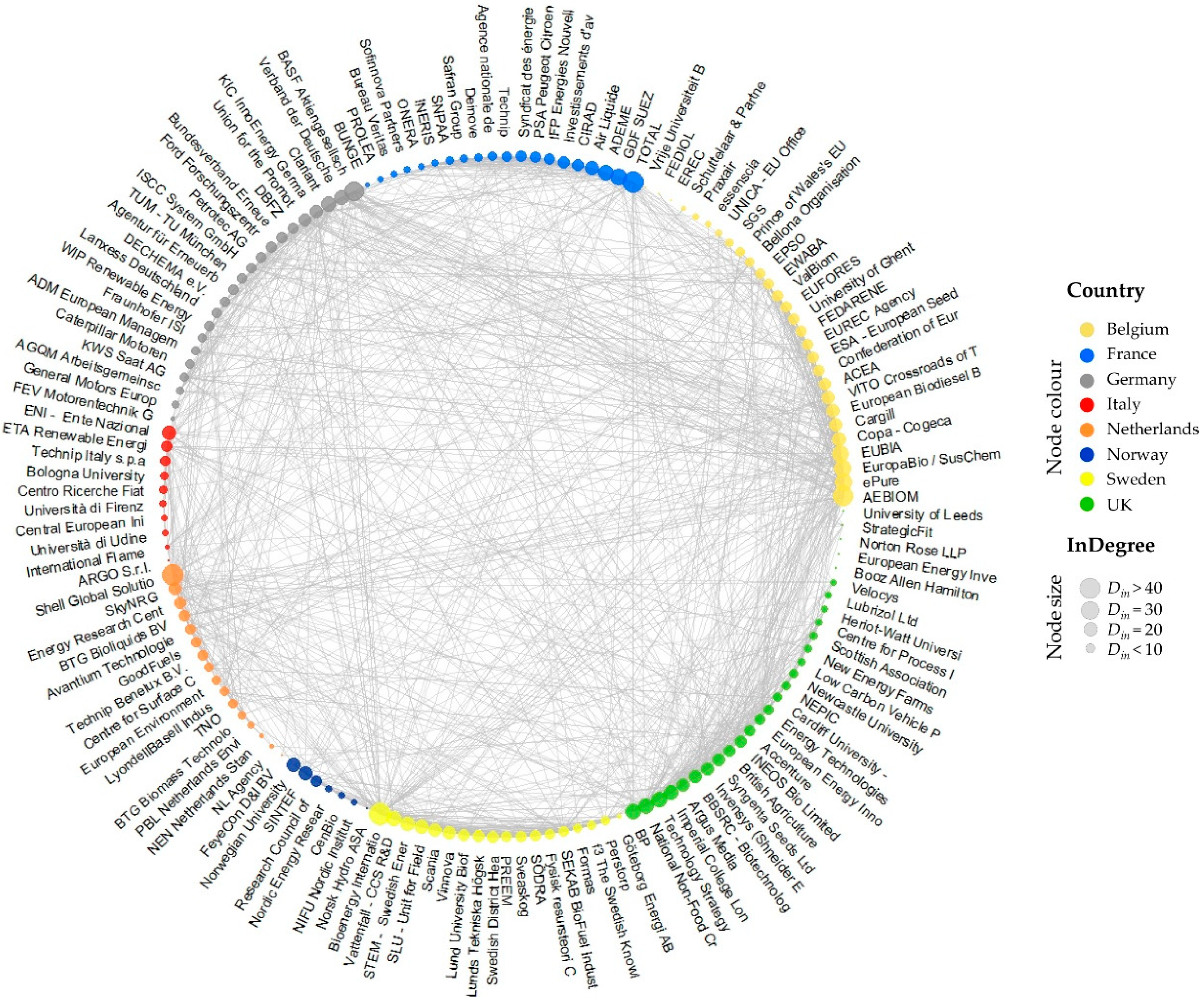
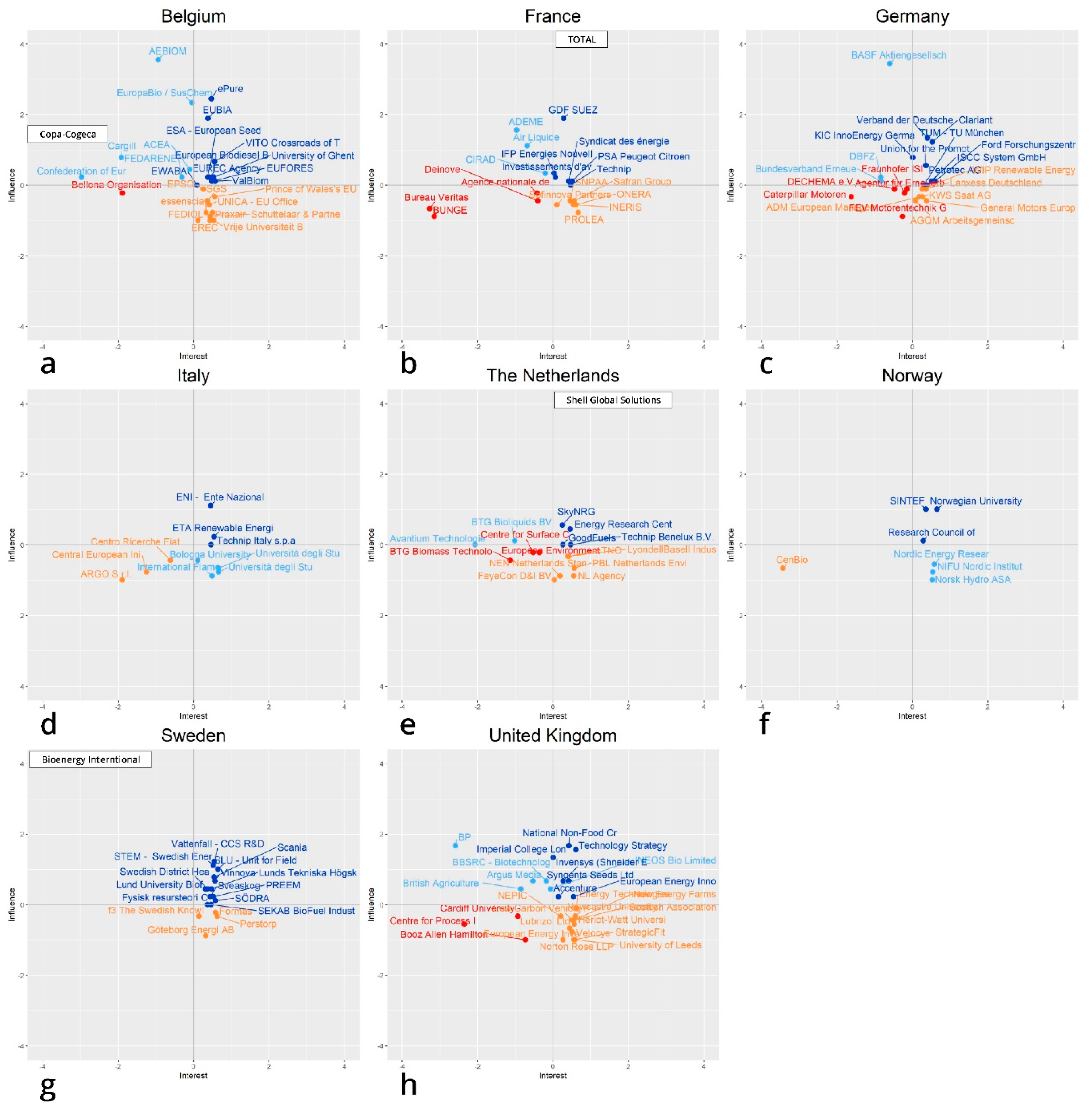

| Term Frequency | |||||
|---|---|---|---|---|---|
| Term | Freq. | Term | Freq. | Term | Freq. |
| Biofuel | 20 | Industry | 5 | Innovation | 3 |
| Biomass | 16 | Catalytic | 4 | Integration | 3 |
| Research | 11 | Integrate | 4 | Liquefaction | 3 |
| Molten salt | 10 | Liquid | 4 | Low carbon | 3 |
| Energy | 9 | System | 4 | Suitable | 3 |
| Fuel | 9 | Transport | 4 | Supply | 3 |
| Sustainable | 9 | Activity | 3 | Technical | 3 |
| Middle distillates | 8 | Advance | 3 | Techno-economic | 3 |
| Technology | 7 | Chain | 3 | Transnational | 3 |
| Bioenergy | 6 | Circular economy | 3 | User | 3 |
| Hydro-pyrolysis | 6 | Feedstock | 3 | ||
| Sustainability | 6 | Flexibility | 3 | ||
Publisher’s Note: MDPI stays neutral with regard to jurisdictional claims in published maps and institutional affiliations. |
© 2020 by the authors. Licensee MDPI, Basel, Switzerland. This article is an open access article distributed under the terms and conditions of the Creative Commons Attribution (CC BY) license (http://creativecommons.org/licenses/by/4.0/).
Share and Cite
Ludovico, N.; Dessi, F.; Bonaiuto, M. Stakeholders Mapping for Sustainable Biofuels: An Innovative Procedure Based on Computational Text Analysis and Social Network Analysis. Sustainability 2020, 12, 10317. https://doi.org/10.3390/su122410317
Ludovico N, Dessi F, Bonaiuto M. Stakeholders Mapping for Sustainable Biofuels: An Innovative Procedure Based on Computational Text Analysis and Social Network Analysis. Sustainability. 2020; 12(24):10317. https://doi.org/10.3390/su122410317
Chicago/Turabian StyleLudovico, Nuccio, Federica Dessi, and Marino Bonaiuto. 2020. "Stakeholders Mapping for Sustainable Biofuels: An Innovative Procedure Based on Computational Text Analysis and Social Network Analysis" Sustainability 12, no. 24: 10317. https://doi.org/10.3390/su122410317
APA StyleLudovico, N., Dessi, F., & Bonaiuto, M. (2020). Stakeholders Mapping for Sustainable Biofuels: An Innovative Procedure Based on Computational Text Analysis and Social Network Analysis. Sustainability, 12(24), 10317. https://doi.org/10.3390/su122410317






